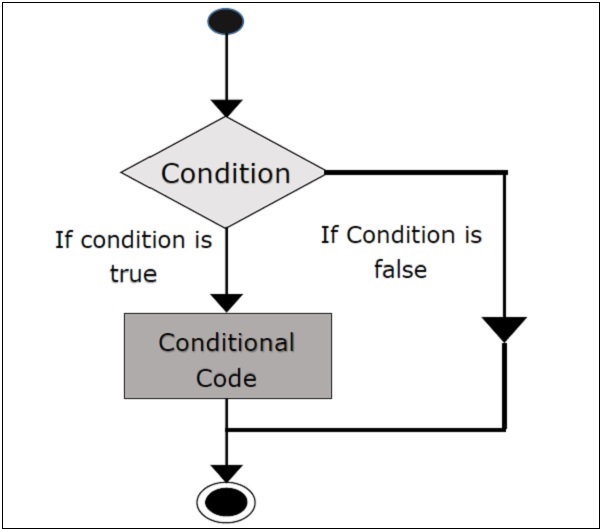斯卡拉 - 如果是的话( IF ELSE)
本章将指导您完成Scala编程中的条件构造语句。 以下是在大多数编程语言中发现IF ... ELSE结构的典型决策的一般形式。
流程图 (Flow Chart)
以下是条件语句的流程图。

如果声明
'if'语句由一个布尔表达式后跟一个或多个语句组成。
语法 (Syntax)
'if'语句的语法如下。
if(Boolean_expression) {
// Statements will execute if the Boolean expression is true
}
如果布尔表达式的计算结果为true,那么将执行'if'表达式中的代码块。 如果没有,将执行'if'表达式结束后(在结束大括号之后)的第一组代码。
尝试使用以下示例程序来理解Scala编程语言中的条件表达式(如果表达式)。
例子 (Example)
object Demo {
def main(args: Array[String]) {
var x = 10;
if( x < 20 ){
println("This is if statement");
}
}
}
将上述程序保存在Demo.scala 。 以下命令用于编译和执行此程序。
Command
\>scalac Demo.scala
\>scala Demo
输出 (Output)
This is if statement
If-else 语句
'if'语句后面可以跟一个可选的else语句,该语句在布尔表达式为false时执行。
语法 (Syntax)
if ... else的语法是 -
if(Boolean_expression){
//Executes when the Boolean expression is true
} else{
//Executes when the Boolean expression is false
}
尝试使用以下示例程序来理解Scala编程语言中的条件语句(if- else语句)。
例子 (Example)
object Demo {
def main(args: Array[String]) {
var x = 30;
if( x < 20 ){
println("This is if statement");
} else {
println("This is else statement");
}
}
}
将上述程序保存在Demo.scala 。 以下命令用于编译和执行此程序。
Command
\>scalac Demo.scala
\>scala Demo
输出 (Output)
This is else statement
If-else-if-else 语句
'if'语句后面可以跟一个可选的' else if...else '语句,这对于使用单个if ... else if语句测试各种条件非常有用。
当使用if,else if,else语句时,要记住几点。
一个'if'可以有零个或一个其他的,它必须在任何其他if之后。
一个'if'如果有的话可以有零到多个,并且它们必须在else之前。
一旦其他成功,如果其他人或其他人将被测试,他将不会留下其他人。
语法 (Syntax)
以下是'if ... else if ... else'的语法如下 -
if(Boolean_expression 1){
//Executes when the Boolean expression 1 is true
} else if(Boolean_expression 2){
//Executes when the Boolean expression 2 is true
} else if(Boolean_expression 3){
//Executes when the Boolean expression 3 is true
} else {
//Executes when the none of the above condition is true.
}
尝试使用以下示例程序来理解Scala编程语言中的条件语句(if- else- if- else语句)。
例子 (Example)
object Demo {
def main(args: Array[String]) {
var x = 30;
if( x == 10 ){
println("Value of X is 10");
} else if( x == 20 ){
println("Value of X is 20");
} else if( x == 30 ){
println("Value of X is 30");
} else{
println("This is else statement");
}
}
}
将上述程序保存在Demo.scala 。 以下命令用于编译和执行此程序。
Command
\>scalac Demo.scala
\>scala Demo
输出 (Output)
Value of X is 30
Nested if-else 语句
嵌套if-else语句总是合法的,这意味着你可以在另一个if或else-if语句中使用一个if或else-if语句。
语法 (Syntax)
嵌套if-else的语法如下 -
if(Boolean_expression 1){
//Executes when the Boolean expression 1 is true
if(Boolean_expression 2){
//Executes when the Boolean expression 2 is true
}
}
尝试使用以下示例程序来理解Scala编程语言中的条件语句(nested-if语句)。
例子 (Example)
object Demo {
def main(args: Array[String]) {
var x = 30;
var y = 10;
if( x == 30 ){
if( y == 10 ){
println("X = 30 and Y = 10");
}
}
}
}
将上述程序保存在Demo.scala 。 以下命令用于编译和执行此程序。
Command
\>scalac Demo.scala
\>scala Demo
输出 (Output)
X = 30 and Y = 10
